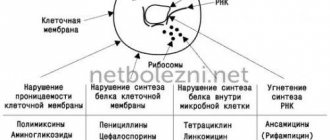Dictionary of medical terms (List)
Page 1 of 10
Dictionary of medical terms for medical students, doctors, graduate students, residents and interns.
| | | | | | | | | | | | | | | | | | | | | | | | |
A
Abasia - (from Latin a.-negation, bacis-walking) - inability to walk.
Aberration is a deviation from the normal structure, a weak degree of anomaly.
Abdominal - abdominal.
Abiosis is reduced vitality of an organ or system, weakened function due to congenital weakness.
Ablepsy is blindness.
Ablepharia is the absence of one eyelid or both eyelids.
Ablation is the removal or removal of a body part through surgical amputation.
Abortion (syn.: miscarriage) is the termination of pregnancy in the first 28 weeks, when the fetus is not yet viable.
Abrasion (syn.: curettage) - scraping with a sharp spoon (of the uterus or gum pocket tissue).
Apricot tumor is a myoma of myoblasts, myoblastoma.
Absence is a momentary blackout of consciousness, more often in epileptics.
Absorption 1 - absorption (liquids, gases).
Absorption2 - absorption, absorption of substances in tissues by lymphatic and blood vessels.
Abstinence is a phenomenon of deprivation, or abstinence (from alcoholic beverages, drugs, sexual intercourse).
Abscess ( syn.: abscess, abscess ) is a cavity filled with pus and delimited from surrounding tissues and organs by a pyogenic membrane; one of the types of purulent inflammation.
Abulia - indecision, lack of will.
Autonomous - self-governing (cell growth in tumors).
Agar-agar is a medium for growing microbes.
Agglutination1 - gluing of blood cells into piles and precipitation.
Agglutination2 - gluing (accumulation) of bacteria, red blood cells and cellular elements into piles and their sedimentation when adding immune serum, etc.
Aggravation is an exaggeration of a minor health disorder or illness.
Agenesis is the congenital absence or underdevelopment of an organ, part of an organ or part of the body.
Agony is a state preceding the onset of death, death torment.
Agranulocytosis is a syndrome characterized by the absence of granulocytes in the peripheral blood or a decrease in their number below 750 in 1 μl.
Adamantinoma ( syn .: ameloblastoma ) is a benign epithelial tumor in which structures that resemble dental (enamel) tissue are formed; usually occurs in the thickness of the jaw.
Adaptation is adaptation to changed conditions.
Adventitia is the outer connective tissue layer of the wall of blood vessels or other tubular organs.
Adhesion - in morphology - fusion of serous membranes as a result of inflammation, gluing, sticking, sticking together, fusion.
Addison's disease - (see bronze disease) a disease that occurs with asthenia, adynamia, pigmentation of the skin and some mucous membranes, with achylia, hypotension; occurs as a result of chronic adrenal insufficiency, most often due to tuberculosis.
Adenitis is inflammation of a lymph node (gland).
Adenoids are growths of lymphoid tissue in the palatine tonsils.
Adenocarcinoma (syn.: glandular cancer) is a malignant tumor built like glandular epithelium.
Adenoma is a benign tumor that arises from the glandular epithelium and retains structural similarity to the original tissue.
Adenomyosis is the presence of endometrial elements outside of its normal place (endometriosis).
Adenomyoma is a benign tumor of mixed histogenesis from muscle and glandular tissue.
Adenopathy is a collective designation for diseases of the lymph nodes of a non-tumor and non-inflammatory nature.
Adynamia - powerlessness, weakness.
Adnexitis is inflammation of the uterine appendages (ovaries, tubes).
Adsorption - surface absorption, absorption, absorption in surface layers; concentration of any gaseous or dissolved substance by the surface layer of the adsorbent.
Azospermia is the absence of moving sperm in the seminal fluid (male infertility).
Azotemia is an increase in the level of so-called residual nitrogen in the blood.
Acanthosis is a thickening of the epidermis and epithelium of the mucous membranes with elongation of the interpapillary processes.
Acantholysis is a degenerative change in the spinous layer of the epidermis, manifested by the destruction of intercellular bridges, loss of most of the cytoplasm by cells and morphological changes in the nuclei; leads to the formation of bubbles.
Acclimatization is adaptation to new climatic conditions.
Accommodation is the adaptation of the eye to clearly see objects located at different distances from it.
Accumulation - accumulation, accumulation.
Acne is acne, a collective term for skin diseases with the formation of papules and pustules due to inflammation of the sebaceous glands and hair follicles.
Acromegaly is a pathological elongation of the limbs, ears, nose, and jaws.
Acrocyanosis is a bluish discoloration of the distal parts of the body due to venous stagnation, most often with right heart failure.
Acceleration - speeding up, speeding up; accelerated growth in children .
Actinomycosis is a chronic infectious disease that is caused by the radiant fungus Actinomuces and is characterized by the formation of dense infiltrates and fistulas mainly in the maxillofacial area.
Accidental1 - accidental, secondary , insignificant.
Accident2 - an accident, an unexpected injury or injury.
Aleukia is a disease of the hematopoietic organs, characterized by a sharp decrease in the number of leukocytes or their disappearance, a sharp decrease in the number of platelets and difficult regeneration of red blood cells.
Alimentary - nutritional, related to food, associated with food or nutrition.
Allergen is a substance that causes an allergic reaction, causing sensitization and allergic diseases in susceptible individuals.
Allergy is an altered reactivity of the body, increased sensitivity of the body due to its sensitization by some protein or microbe in relation to repeated exposure to the same allergen.
Alopecia is hair loss most often on the head, as well as hair loss from the beard, eyebrows, and mustache.
Aloe is the juice from the leaves of African plants.
Albuminuria is the excretion of protein in the urine due to kidney disease.
Alveolitis is an inflammation of a group of lung alveoli without damage to the bronchial tree.
Alveolar - cellular.
Alteration1 is damage to cells, tissues and organs, accompanied by disruption of their vital functions.
Alteration2 - damage, disruption, death (dystrophy and necrosis).
Amebiasis is a disease caused by Entamoebahistolytica that affects the large intestine (amoeba dysentery).
Amenorrhea is the absence of menstruation for 6 months or more in those years and periods when the patient should normally menstruate.
Amyloid is a protein substance of the globulin type, consisting of F-fibrillar and P-plasma components, which is deposited in tissues during amyloidosis.
Amyloid bodies are homogeneous or layered rounded microscopic inclusions formed in organs and tissues due to the deposition of proteins in them (they should not be identified with amyloid).
Amyloidosis is a vascular-stromal dysproteinosis, characterized by deposition of amyloid (an abnormal glycoprotein) in tissues and leading to parenchymal atrophy, sclerosis and functional organ failure.
Amitosis is the division of a cell into two parts.
Amorphous - shapeless.
Amputation - cutting off (surgical or traumatic) of any significant part of the body
Cupid (Cupid, Eros) is the god of love.
Anabiosis is a temporary, almost complete cessation of life processes in the body.
Analgia (analgesia) is insensitivity to pain.
Anamnesis is the history of the development of the disease.
Anaplasia (syn.: cataplasia) is a persistent dedifferentiation of malignant tumor cells with a change in their structure and biological properties (poorly differentiated malignant tumor).
Anasarca is a common swelling of the subcutaneous tissue of the body.
Anastomosis is a surgical connection of the lumens of hollow organs.
To dissect is to dissect a corpse for scientific purposes.
Pathological anatomy (syn.: pathological morphology, pathomorphology) is a medical science that studies pathological processes and diseases using morphological research methods; the science of the morphological substrate of diseases.
Anaphase is the third phase of cell division (mitosis).
Anaphylaxis is an acquired hypersensitivity to the action of any antigen, reintroduced parenterally no earlier than after 7 days.
Anaerobes are bacteria that live in the absence of oxygen.
Sore throat is an acute infectious disease caused by streptococci and staphylococci, less often by other microorganisms, characterized by inflammatory changes in the lymphadenoid tissue of the pharynx, most often the tonsils; manifested by sore throat and moderate general intoxication.
Angiokeratoma is the general name for dermatoses characterized by the presence in the skin of single or multiple vascular formations such as angiomas, accompanied by hyperkeratosis.
Angiolitis is a calculus in the lumen of a blood vessel or in the cavity of an angioma, which is a calcified thrombus.
Angioma is a benign tumor that develops from blood (hemangioma) or lymphatic (lymphangioma) vessels .
Angiomatosis1 - multiple angiomas.
Angiomatosis2 is the general name for diseases characterized by excessive proliferation of blood vessels.
Angiosarcoma is the general name for malignant tumors that develop from blood or lymphatic vessels.
Angioendothelioma is a malignant tumor that develops from the endothelium of blood and lymphatic vessels (hemangioendothelioma, lymphagioendothelioma).
Angiectasia is a persistent expansion of the lumen of a blood or lymphatic vessel due to pathological changes in its wall or impaired blood (lymph) circulation.
Androgens are male hormones.
Androsteroma is a hormonally active tumor of the adrenal cortex that produces male sex hormones.
Androphobia is man-hatred.
An aneurysm is an expansion and protrusion of the lumen of a blood vessel or heart cavity due to pathological changes in their walls or developmental abnormalities.
Anemia (syn.: anemia) - a decrease in the number of red blood cells, hemoglobin content in a volumetric unit of blood.
Anesthesia - loss of sensitivity, pain relief.
Aneuploidy is the loss or addition of chromosomes.
Anisocytosis - different sizes of red blood cells, leukocytes, tumor cells, etc.
Ankylosis is immobility of a joint due to pathological fusion of the articular surfaces.
Anoxia is a lack of vision in one eye.
Anomaly is a deviation from the norm (usual, physiological), incorrect structure.
Anophthalmia is the absence of one or two eyes.
Antipodes are people with opposite views and character traits.
Antiseptics - (syn: asepsis) - prevention of wound infection.
Anthracosis is the deposition of coal dust in the lungs.
Anthropology is the science of human origins and evolution.
Anuria is the cessation of urine secretion by the kidneys.
Anus prae ternaturalis - unnatural anus; a loop of the colon is brought out onto the abdominal wall, where feces come out; performed for intestinal obstruction due to cancer.
Aortitis is a diffuse inflammation of the walls of the aorta.
Apathy is indifference, indifference.
Apical - facing upward, apical.
Aplasia is a congenital absence of an organ, congenital underdevelopment of tissues.
Apnea is a temporary cessation of breathing.
Apocrine - (separating from oneself) when secretion is released, the apical part of the gland cell is rejected, for example, in the sweat glands.
Aponeurosis is a tendon stretch.
Apoplexy 1 is a stroke, a sudden or very rapid cessation of the activity of the brain or its individual parts due to an acute disorder of cerebral circulation, accompanied by loss of consciousness and paralysis.
Apoplexy 2 is a sudden, lightning-fast cessation of the function of an internal organ due to massive hemorrhage or infections.
Appendicitis is inflammation of the appendix of the cecum.
Application - wrapping or applying material to the skin for therapeutic purposes.
Arachnoiditis is an inflammation of the soft meninges of the brain or spinal cord with predominant damage to the arachnoid membrane.
Areola - redness of the skin around the breast nipple or sore.
Arrhythmia is a disorder of the heart with a lack of rhythm.
Arrosion - 1) violation of the integrity of blood vessels due to ulcerative-necrotic and purulent processes; 2) violation of the integrity of the cartilaginous surfaces of the joints due to inflammatory, degenerative or tumor lesions.
Arteritis is inflammation of the artery wall.
Arteriolonecrosis - arteriosclerosis, occurring with fibrinoid necrosis of the vascular wall, is observed, for example, in malignant hypertension, rheumatic diseases.
Arteriolosclerosis is a lesion of arterioles and small arteries of the muscular type, characterized by sclerotic thickening of the walls of blood vessels with a significant narrowing of their lumen or cicatricial obliteration of vessels with perivascular sclerosis.
Arteronephrosclerosis - atherosclerosis of the internal arteries of the kidney; leads to the formation of an arteriosclerotic kidney.
An artifact is a formation, a particle, that is normally unusual for the body.
Arthritis - inflammation of the joints or some of its elements
Asbestosis is pneumoconiosis caused by prolonged inhalation of asbestos dust.
Asynergia is uncoordinated movements of the arms and legs due to cerebellar disease.
Asystole is a sharp weakening of contractions of the heart muscle.
Roundworms are roundworms found in the human intestines.
Aspiration is the entry of foreign particles or substances into the airways during inhalation.
Assimilate - assimilate.
Asthma - periodic attacks of shortness of breath.
Astroblastoma is a malignant tumor of astrocytic glia.
Astrocytoma is a benign glial tumor derived from astrocytes.
Asphyxia is oxygen starvation due to difficulty breathing.
Ascites is dropsy, accumulation of transudate in the abdominal cavity.
Atavism is the appearance of signs in a given person that are not present in the parents, but exist in his close or distant great-grandfathers.
An attack is a new attack, for example, of rheumatism.
Atelectasis is a condition of the lung or part of it in which the alveoli do not contain air and appear collapsed.
Atherocalcinosis is the calcification of atherosclerotic plaques of blood vessels, observed in the late stages of atherosclerosis.
Atheroma is a cyst of the sebaceous gland that occurs as a result of a violation of the outflow of secretions.
Atheromatosis is a stage of development of an atherosclerotic plaque, characterized by lipoid infiltration of the inner lining of an artery of elastic and mixed type, followed by the development of connective tissue in their wall; A. is clinically manifested by general and (or) local circulatory disorders, some of which are divided into separate nosological forms.
Atherosclerosis is a chronic disease characterized by lipoid infiltration of the inner lining of the artery of the elastic and mixed type with the subsequent development of connective tissue in their wall; A . clinically manifested by general and (or) local circulatory disorders, some of which are classified into separate nosological forms (CHD).
Atypia is a deviation from the norm.
Atony - weakening of tone (stomach, intestines, muscles).
Atresia is a congenital absence of one or another natural opening in the body; less often - acquired absences.
Atrophy is a decrease in the mass and volume of an organ or tissue, accompanied by a weakening or cessation of their functions: based on A. There are disorders of tissue nutrition, leading to the gradual replacement of parenchymal elements with fibrous tissue.
Aura is the feeling of a breeze before an epileptic attack.
Auscultation - listening to sound phenomena in the heart and lungs.
Autolysis is the melting and disintegration of cells and tissues of the body under the influence of the hydrolytic enzymes they contain.
Autolysosome - a lysosome in which the destruction of dying intracellular structures occurs; A - participate in the processes of physiological intracellular regeneration and autolysis.
Autopsy - section, opening and examination of a corpse.
Aphasia is loss of speech.
Aphthae are small areas of superficial necrosis of the epithelium of the mucous membranes in the form of yellowish-gray rounded erosions or small ulcers with a bright red inflammatory rim.
Affect is the primary focus of tuberculous inflammation.
Affinity is the ability of various cells and tissues to fix, perceive or bind certain chemicals, the chemical property of tissues and cells or their parts to dyes.
Achalasia is the impossibility (difficulty), relaxation of the sphincter of the internal organs. For example: gastric acholasia.
Acheilia is a congenital absence of lips.
Ahilia is the absence of hydrochloric acid and pepsin in gastric juice.
Achromatosis, achromia (syn.: albinism, vitiligo) - lack of skin pigmentation, pigment in the iris.
Acephaly is a congenital deformity in the form of the absence of the brain part of the skull.
Acidosis is an excess of acids in the blood.
Acinus is a group of alveolar ducts in the lungs ending in alveolar sacs.
- To the begining
- Prev
- 1
- Next
- In the end
Dictionary of medical terms
An abscess is an abscess, an abscess. A cavity filled with pus and delimited from the surrounding tissue.
Adaptation is the process of adapting an organism, system, organ to changed conditions of existence (functioning) by changing the structure, metabolism, and function.
Beta-Adrenergic blockers - drugs that prevent the interaction of the mediator with adrenergic receptors (propranolol and its derivatives)
Alkalosis is a disorder of the acid-base state, characterized by the appearance in the blood of an absolute or relative increase in the number of bases and a decrease in the number of hydrogen ions.
Allergen is an antigen that causes an allergy.
Allergy is increased sensitivity to the effects of any substances or to components of one’s own tissues.
Angiopathy is a violation of the tone of blood vessels, caused by a disorder of nervous regulation and manifested by transient spasms and dystonia.
Anemia (anemia) is a condition characterized by a decrease in hemoglobin content per unit volume of blood, often with a simultaneous decrease in the number of red blood cells.
Anisocytosis is the presence in the blood of red blood cells with a diameter larger (macrocytosis) than normal (7-8 microns).
Anorexia is a lack of appetite in the presence of a physiological need for nutrition, caused by disturbances in the functioning of the food center.
Antibiotics are substances that can selectively inhibit the development of microorganisms or certain tumor cells.
Antigen is a substance with characteristic chemical groups (antigenic determinators), which are perceived by the body as foreign, cause a specific immune response, immune memory, and are capable of specifically interacting with antibodies and lymphocytes.
Anticoagulants (anticoagulants) are medications that inhibit the blood clotting process.
Antioxidants are substances that inhibit the processes of free radical peroxidation.
Antibodies are gamma globulins that are formed in response to the introduction of an antigen and have the ability to react specifically with this antigen.
Anuria is the failure of urine to enter the bladder.
Arrhythmia (of the heart) is the general name for disorders of the occurrence of excitation impulses or their conduction through the myocardium. Manifested by disturbances in heart rate and rhythm.
Androgens are male sex hormones.
Anabolic drugs (anabolics) are drugs that cause increased protein synthesis.
Addison's disease is an endocrine disease caused by bilateral damage to the adrenal cortex with a decrease or complete absence of hormone synthesis. It is characterized by a bronze coloration of the skin, impaired water-salt metabolism, and hypotension.
Anamnesis is information about the state of health obtained by interviewing the patient himself or those who know him.
Ascites (hydroperitoneum) is an accumulation of fluid in the abdominal cavity, causing an enlarged abdomen. It can develop as a result of heart failure, portable hypertension, cirrhosis of the liver, as well as various forms of cancer (especially liver and ovarian cancer).
An autoimmune process is the formation of antibodies or activated lymphocytes against cell fragments of healthy tissues and organs of one’s own body.
Acidosis is a violation of the acid-base state, in which there is an absolute or relative accumulation of excess acids and an increase in the concentration of hydrogen ions.
Barbiturates are derivatives of barbituric acid used as sleeping pills, narcotics and anticonvulsants.
Biomaterial is a subject of laboratory research obtained from the human body - biopsy samples of tissues and organs, blood and bone marrow cells, feces, mucus, sputum, hair; biological fluids - serum and blood plasma, urine, lymph, cerebrospinal fluid, ejaculate, sweat, gastric and pancreatic juice, bile, exudate, transudate, synovial and lacrimal fluid, saliva.
Biopsy is the intravital removal of fragments of organs and tissues for histological diagnostic examination.
B. puncture - collection of cells or tissue by puncturing the wall of an organ or cavity with a special hollow needle.
Blast cells (blasts) are the parent elements of all hematopoietic germs. Pathological blast cells in leukemia differ from normal ones by impaired differentiation ability, morphological and metabolic properties.
Bradycardia is a decrease in heart rate.
Virilizing tumors are tumors that produce androgens and cause the appearance of male characteristics in women - male-pattern hair growth, a deep voice, increased muscle mass, etc.
Virulence is the degree of pathogenicity of a microorganism in relation to a certain species of animal or person; includes the degree of toxicity, the ability to penetrate and multiply in the body.
Viruses are non-cellular life forms that have a genome (DNA or RNA), but are not capable of reproducing outside the cells of other organisms (plants or animals).
Inflammation is a protective-adaptive reaction of the entire organism to the action of a damaging factor and is characterized by an increase in body or local temperature, swelling, redness, and increased vascular permeability in the area of inflammation.
Helminths are a group of worms, including representatives of the classes of trematodes, cestodes, acanthocephalans and nematodes - causative agents of helminthiasis in humans and animals.
Hematology is a branch of internal medicine that studies the causes of occurrence (etiology), the mechanism of development (pathogenesis) and clinical manifestations of diseases of the blood system and develops methods for their diagnosis, treatment and prevention.
Hematuria is the presence of red blood cells in the urine.
Hemolysis is the destruction of red blood cells.
Hyperbaric oxygenation is breathing oxygen under high pressure (1-3 excess atmospheres) in special pressure chambers.
Hyperglycemia is an increased concentration of glucose in the blood.
Hypercoagulation is accelerated blood clotting.
Hyperplasia is an increase in the number of cells and intercellular structures as a result of pathological degeneration of tissue.
Hypertension (hypertension) is increased hydrostatic pressure in blood vessels.
Hyperfunction is an enhanced function of an organ or system.
Hypovitaminosis is a lack of vitamins.
Hypoglycemia is a reduced concentration of glucose in the blood.
Hypocoagulation is a slowdown in blood clotting.
Hypoxemia is a low oxygen level in the blood.
Hypoxia (oxygen starvation) is a deficiency of oxygen in cells, tissues and organs.
Hyposthenuria is the excretion of urine with a constantly low relative density.
The hypothalamus is a section of the brain located beneath the thalamus and forms the floor of the third ventricle. Secretes neurohormones and is the highest subcortical center of the autonomic nervous system.
Hypotension (hypotension) is low blood pressure in the vessels.
The pituitary gland (pituitary gland, cerebral appendage) is an endocrine gland located at the base of the brain (sella turcica). Produces a number of peptide hormones that regulate the functions of other endocrine glands.
Hypofunction is a weakening of the activity of a cell, organ, or system.
Glycogen (animal starch) is a polysaccharide synthesized and deposited in the liver; upon breakdown it forms glucose.
Glycogenolysis is the formation of glucose from glycogen.
Gluconeogenesis is the formation of glucose from proteins and fat.
Risk groups are people who have a non-hereditary predisposition to certain diseases as a result of the presence of risk factors.
Humoral factors are biologically active substances that are formed in various cells, tissues and organs and dissolve in the fluids of the body (blood, lymph, tissue fluid), due to which they can spread in the body and affect other cells and organs.
Desensitization is a decrease in the body's sensitivity to an allergen.
Desquamation is a physiological or pathological process of desquamation of epithelial cells.
Destruction is the destruction of tissue, cellular and subcellular structures.
Detoxification - binding, breaking down and removing toxins from the body.
Dysfunction is a dysfunction of a system or organ. Cells that express themselves in reactions that are inappropriate to the action of the stimulus.
Cell differentiation is a change in the structure of a cell during its development and maturation. Undifferentiated (young) cells are functionally inferior.
Isothenuria - urine output with constant relative density; most often observed with a decrease in the concentrating ability of the kidneys.
Immunization is the development of immunity in the process of interaction with immunogenic factors.
Immunity (specific biological defense, immune defense) is the ability to protect, actively or passively acquired by the human body, specifically directed against immunogenic factors - infectious agents, foreign proteins, etc.
I. congenital - immunity formed at the time of birth.
I. natural (borrowed) - passive immunity of the fetus, early infancy, caused by maternal immunoglobulins passing through the placenta or breast milk.
I. local - provides protection of the integument and organs in direct contact with the external environment (genitourinary organs, lungs, gastrointestinal tract). Provided by mechanical barriers, lysozyme, complement, secretory immunoglobulins, macrophages, etc.
I. acquired - occurs after previous infections, administration of vaccines, ready-made antibodies. Non-inheritable, often unstable.
I. antitumor - immune reactivity towards tumor antigens.
I. transplantation - a change in the state of the recipient’s immune system during transplantation of donor tissues or organs and aimed at their rejection.
Immune tolerance (immune paralysis) - inability to mount an immune response; is temporary and never absolute.
Immunosuppressants (immunosuppressants) are chemical substances that, in therapeutic concentrations, can suppress or weaken the immune response (corticosteroids, protein synthesis antimetabolites, antibiotics, etc.).
Immunodeficiency (immune deficiency) is a congenital or acquired condition. Characterized by the inability to implement any parts of the immune response.
Immunocorrection (immunomodulation) is the correction of defective functioning of the immune system, aimed at strengthening a weakened or inhibiting the stimulated immune system.
I. non-drug - use of plasmapheresis, hemosorption, ultraviolet and laser irradiation of blood, enterosorption, etc. to eliminate disorders in the immune system.
Immunosuppression (immunosuppression) is a nonspecific inhibition of immune reactions.
Immune response - processes that begin after the introduction of an antigen and end with an immune reaction specific to this antigen.
Immune status (profile, reactivity) - characterized by the number and activity of circulating lymphoid and phagocytic cells, the state of the kit system, nonspecific resistance factors, the number and function of killer cells, the concentration of immunoglobulins, interleukins and other indicators.
Incubation period is the period of time from human infection to the appearance of the first clinical signs of the disease.
Intensive therapy is a set of therapeutic measures (medicinal, physiotherapeutic, etc.) aimed at comprehensive and rapid restoration of organ functions. Systems and the body as a whole.
Interferon is a low-molecular protein synthesized in the body and in cell cultures and suppresses the proliferation of viruses and other intracellular parasites.
Intoxication (poisoning) is a pathological condition caused by the general effect on the body of toxic substances of external or internal origin.
Injection is the introduction of liquid into the body using a syringe.
Ischemia is a decrease or cessation of blood supply to a tissue area, organ, or part of the body.
Ketonemia is an increase in the concentration of ketone bodies in the blood.
Ketonuria is an increase in the concentration of ketone bodies in the urine.
Coagulogram is a set of results of a complex laboratory state of the blood coagulation system.
Coagulation (clotting) is the connection between platelets, red blood cells, fibrin threads and the formation of a blood clot (thrombus).
Skin tests are a method of identifying specific hypersensitivity of the body to certain substances (allergens).
Collagen is a protein that is the main structural element of collagen fibers and connective tissue.
Collapse is an acute vascular insufficiency with a drop in vascular tone and a decrease in the mass of circulating blood, a sharp decrease in blood pressure, signs of cerebral hypoxia and depression of vital functions.
Colpitis is an inflammation of the vaginal mucosa.
Complement is a complex of plasma proteins, including about 30 proteins and proteolytic enzymes that ensure the lysis of the membranes of viruses, bacteria, cancer cells and the preparation of their fragments for absorption by macrophages.
Conjunctiva - inflammation and secretion of milk from the mammary glands.
Laryngitis is inflammation of the larynx.
Leukogram - see Leukocyte formula.
Leukopenia is a reduced concentration of leukocytes in the blood (less than 4-109/l).
Leukocyte formula (leukogram) is the percentage of different types of leukocytes in the peripheral blood. Counted on a stained blood smear.
L.F. Shift to the left - an increase in the relative or absolute number of young cells of the granulocytic series (band and young neutrophils), in severe cases - myelocytes, promyelocytes, myeloblasts.
Leukocytosis - an increase in the total number of leukocytes (above 9 * 109/l).
Mortality is a static indicator representing the ratio (in %) of the number of deaths to the number of patients with a certain disease over a certain period of time: used to characterize the danger of a disease, operation, etc.
Lysis (decomposition, dissolution) is the breakdown of microbes, cells or tissues under the action of their own (autolysis) or external enzymes.
Liquor (cerebrospinal fluid) is the fluid that fills the cavities of the brain and spinal cord. Composition studies are used to diagnose lesions of the central nervous system.
Lymph is a liquid tissue of the body contained in lymphatic vessels and nodes.
Lymphopenia is a reduced concentration of lymphocytes in the blood.
Macrocytosis is the presence in the blood of formed elements (blood cells) with sizes exceeding the physiological norm.
Megaloblasts are the parent hematopoietic cells, characteristic of pernicious (B12-deficiency) anemia and differing in structure from normoblasts.
Mediator is the general name for biologically active substances. Produced by cells and mediating intercellular and intertissue interactions.
Menopause is the cessation of menstruation, cyclical changes in the production of hormones and the lining of the uterus, and reproductive function.
Metabolism (metabolism and energy) is a set of processes of transformation of substances and energy within a cell, tissue, organ, organism.
Myelogram is the percentage of cells of varying degrees of maturity of all hematopoietic germs in the bone marrow.
Microhematurgia is the presence of red blood cells in the urine, detected only by microscopic examination.
Microflora (bacteriological, microbial landscape) is an evolutionarily developed set of different types of microorganisms that live on body surfaces, mucous membranes, wounds, etc.
Monoclonal antibodies are antibodies synthesized in hybridomas, a cell clone obtained as a result of the fusion (hybridization) of lymphocytes and plasmacytoma cells.
Monocytosis is an increase in the concentration of monocytes in the blood.
Heredity is the property of transmitting to offspring the characteristics and features of the structure and development of parents.
Neuritis is a lesion of a nerve with changes in its interstitium, myelin sheath and axial cylinders.
Neutrophilia is an increase in the concentration of neutrophil granulocytes in the blood.
Neutrophilic leukocytosis is an increase in the concentration of leukocytes in the blood due to the population of neutrophils.
Necrosis (death) is the irreversible cessation of tissue activity.
Nephrotic syndrome is a combination of high protein content in the urine, edema and disturbances in the spectrum of lipids in the blood; observed with kidney damage.
Nocturia (nocturnal polyuria) is the passage of most of the daily amount of urine at night.
Normal value, norm - a quantitative indicator of the optimal range of substance content, function indicators, etc.
Oliguria is a decrease in daily urine output.
Orchitis is inflammation of the testicle.
Parasitic diseases are diseases that occur when parasites (helminths, insects, protozoa) penetrate the human body.
Pasty - puffy, pasty.
Pathogenicity is the ability of viruses, microbes, fungi, protozoa, etc. to cause disease in humans or animals.
Pathogenic bacteria are bacteria that cause infectious and inflammatory diseases.
A pathological process is a process of vital activity of systems, organs, cells that deviates from the norm (caused by disease).
Pathology is a deviation from the norm.
Pyuria is the presence of pus in the urine.
Blood plasma is the liquid part of the blood that remains after the cells (formed elements) are removed.
Poikilocytosis is the presence in the peripheral blood of red blood cells that are not round, but of some shape (oval, pear-shaped, stellate, etc.)
Polyneuritis is multiple inflammation of peripheral nerves.
Polyuria is increased daily urine output.
Polychromatophilic normoblasts are cells of the erythroid series that can be stained with both basic and acidic dyes. Appears with pernicious
(B12-deficiency) anemia.
The prenatal period (embryonic, intrauterine period) is the period of development of the child in the mother’s body.
Proliferation is the reproduction (division) of cells.
Proteinuria is the presence of protein in the urine when determined by standardized methods.
The rosette formation reaction is a method for identifying various subpopulations of lymphocytes by reaction with sheep or mouse erythrocytes (adhesion of erythrocytes to the cell surface with the formation of a rosette).
Resuscitation (revival of the body) is a set of therapeutic measures aimed at restoring fading or recently extinguished vital functions - breathing,
cardiac activity, vascular tone, etc.
Rheumatoid factor - antibodies to the Fc fragment of immunoglobulin G.
The Rh factor is a system of six isoantigens located on the surface of human erythrocytes and determining their phenotypic differences.
Convalescence - recovery.
Remission is a stage in the course of the disease, characterized by a temporary weakening or disappearance of its manifestations; in some diseases it can last for months or years.
Reticulocytosis is an increase in the number of reticulocytes in the peripheral blood (more than 1.5% of the number of red blood cells). A sign of erythropoiesis tension.
Blood clot retraction is the contraction and reduction in volume of the blood clot with the release of serum.
A cellular receptor is a highly specialized protein formation on the outer surface of cell membranes that has selective sensitivity to physical agents and is capable of transforming the energy of an external stimulus into a cellular response.
Relapse is the reappearance of signs of the disease after remission.
Wounds - inflammation of the nasal mucosa.
Sanitation is a set of measures to identify, eliminate and prevent pathological changes.
Sepsis is a pathological condition caused by the continuous or periodic entry of microorganisms from the focus of purulent inflammation.
Serous fluid is fluid. Produced by serous membranes.
S. shell - the membrane lining the walls of the cavities of the body. Covering the organs located in them - peritoneum, pleura, pericardium, testicular membrane.
Serological reaction is an antigen-antibody reaction, registered on the basis of one of the phenomena accompanied by the formation of an immune complex (precipitation, agglutination, complement fixation).
Serological research is the study of antigens and antibodies using serological reactions for the purpose of diagnosis, determining blood groups or the type of protein.
Sideroblasts are immature erythroid cells containing iron granules. Detected in the bone marrow in sideroblastic anemia.
A symptom is a sign of a pathological condition or disease.
A syndrome is a set of symptoms united by a single pathogenesis.
Synovial fluid is a viscous fluid secreted by the synovial membrane into the joint cavity and lubricates and nourishes the articular cartilage.
Scarification is the application of small incisions to the surface of the skin during cutaneous vaccination.
Hidden blood is blood. Contained in feces in quantities. Revealed only by special reactions.
Medium molecular weight peptides are peptides with a molecular weight from 300 to 5000 Daltons.
Staphylococci are a genus of bacteria that are conditionally pathogenic for humans.
Streptococci are a genus of bacteria, some of which are pathogenic to humans.
Low-grade fever (low-grade fever) - body temperature within 37-38°C.
Serum is the blood plasma from which fibrin is removed during clot formation.
Tachycardia is an increase in heart rate.
The thymus is the thymus gland located between the trachea and the sternum.
Antibody titer is an indicator of antibody concentration, expressed as a dilution factor of the test material (from 1:10 to 1:1000, depending on the reaction and type of antibodies).
Toxicosis is a pathological condition caused by poisoning or the release of toxins into the blood.
Toxins are substances of bacterial, plant or animal origin that, if they enter the human body, can cause disease or death.
Transplantation (transplantation) - replacement of tissues or organs that are missing or damaged by a pathological process, with one’s own tissues or organs and tissues,
taken from another organism.
Transudate (exudate, edematous fluid) is a protein-poor fluid that accumulates in tissues or body cavities due to general or local circulatory disorders, increased sodium concentration, decreased protein concentration, etc.
Thrombocytopenia is a decrease in the concentration of platelets in the blood.
Uroproteinogram is a spectrum of proteins contained in urine and separated by electrophoresis.
Phagocytosis is the process of active capture and absorption of microorganisms, destroyed cells, foreign particles, and immune complexes.
Phagocytes are cells capable of carrying out phagocytosis - macrophages and segmented neutrophils.
Risk factors are external influences or internal disorders (metabolism and functions) that are not the direct cause of a particular disease, but increase the likelihood of its occurrence.
Feminization is the appearance of secondary female sexual characteristics in men, caused by dysfunction of the endocrine glands.
Feminizing tumors are tumors that produce estrogen and lead to feminization.
Liver cirrhosis is the replacement of normal liver parenchyma with connective tissue with impaired liver function.
Cytostatic drugs (cytostatics) are drugs that suppress cell division. Used to stop the growth of malignant tumors.
Cytotoxicity is the ability to damage cells and cause their death.
Excretion is the release of substances outside the body, organ, or cell.
Exudate is a protein-rich liquid containing blood cells that leaves small veins and capillaries into the surrounding tissues and body cavities during inflammation.
Electrophoresis is a method of separating in an electric field amino acids, proteins, lipoproteins, enzymes, etc., which carry a surface charge, on various carriers.
Endrogenic intoxication is intoxication (poisoning) of the body with certain metabolic products, which occurs when their excretion is insufficient or their formation is increased.
Endocervicitis is an inflammation of the mucous membrane of the cervical canal.
Enterosorbents are predominantly organic substances of a certain structure that can adsorb other organic and inorganic substances on the surface. When taken orally, the sorption process occurs in the intestines.
Encephalopathy is the general name for brain diseases characterized by degenerative changes.
Eosinopenia is a decrease in the number of eosinophils in the blood.
Epithelium is tissue. The lining surface of the body (epidermis), mucous membranes of hollow organs. Performs protective, secretory and other functions.
Eostrogens are female sex hormones.
home · english · about the company · products · news · seminars · dealers · service center · site map










